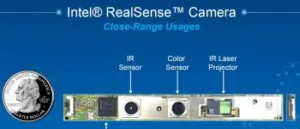Dr Achin Bhowmik of Intel made himself popular with delegates by saying how fantastic today’s displays are. Customers want to buy products just because of the great displays. However, human interfaces are still largely “archaic”. For example, the TVs are wonderful, but the remote control is awful. How do you make it intuitive, he asked? In PCs, there is just a mouse and keyboard for most people.
Touch has helped to make things more intuitive, but on small displays, the touching finger masks the image. Bhowmik has written a book about display interaction which is part of the Wiley/SID series. Most of the brain is devoted to sensory inputs. There are three stages in interaction – sensing (and transduction from one form to electronic), then perception (or recognition) which is usually software, but then there is an action which is an art to make the interaction easy and comfortable.
Bhowmik then talked about Intel’s RealSense 3D depth camera technology which allow a colour image and a depth image. The depth can be measured at 60fps and then software people can “do miracles” with the data provided. Intel has invested a lot of money to develop a small but effective system which is now being sold in high volume.
Turning to the SDK, the system allows developers to understand exactly where the users hands are – much more information than just mouse clicks. The depth cameras can track the face in great detail. Backgrounds can be replaced and AR applications can become much more powerful. There are systems from a number of PC makers and there are a lot of software partners.
Do people pay for human interfaces, he asked? Bhowmik said that the first wireless remote controls added 30% to the cost of the TV. Despite the cost, there was huge demand. It’s all about compelling experiences. Finally, he ended with a demonstration of how the system could track the hand in real detail, in real time.

